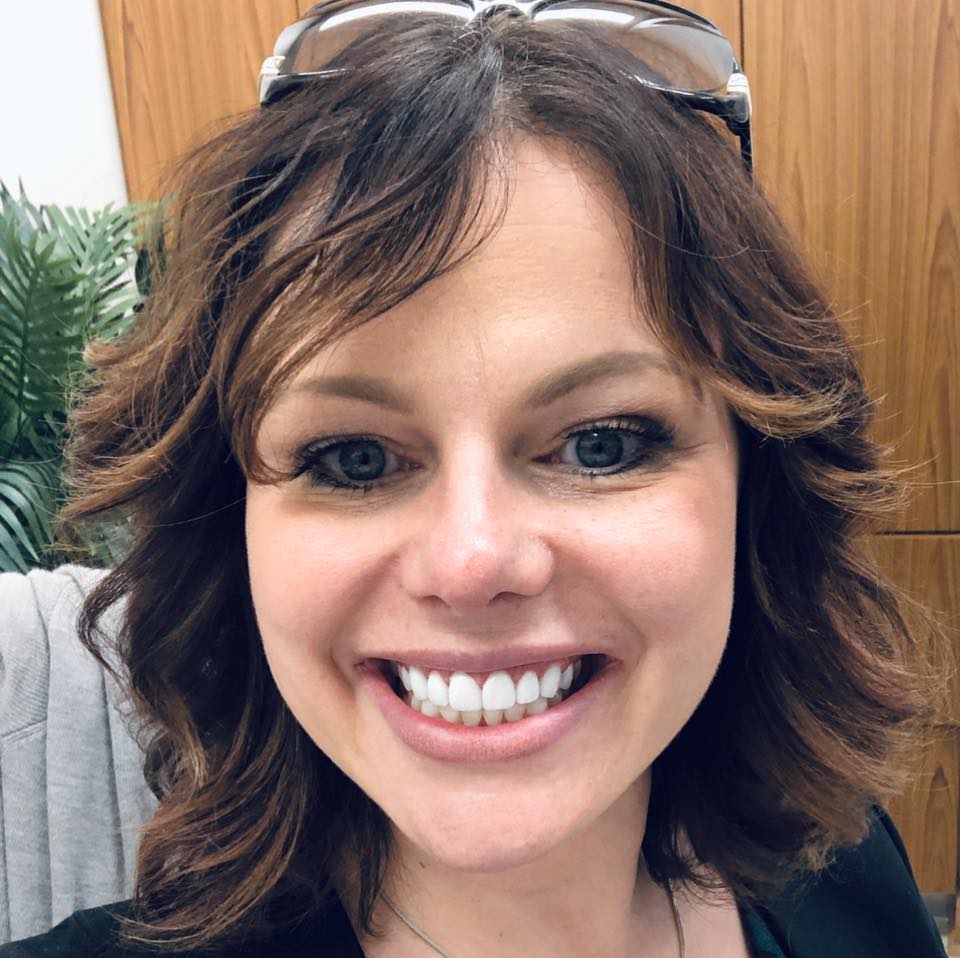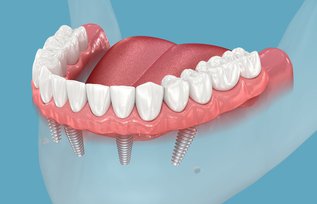
5 Key Questions People Ask About All on Four Dental Implants
If you’ve ever heard of “Teeth in a Day” and wondered what makes it so transformative, you’re not alone. Known clinically as All on Four dental implants, this innovative procedure gives patients a permanent, stable, and natural-looking set of teeth — all in one day.
Whether you’re tired of the limitations of dentures or researching long-term alternatives, understanding this treatment can help you make the right choice for your smile. Below, we answer the five most common questions about All on Four dental implants, with insights from Skymark Smile Centre dentists Dr. Goli Ariafar, DDS, and Dr. Rob Eisen, DDS.
Key Takeaways
- All on Four replaces a full arch of teeth using only four strategically placed implants.
- The treatment is completed in one day, providing immediate results and restored function.
- It’s more stable and comfortable than removable dentures and requires fewer implants than traditional full-mouth reconstruction.
- Maintenance is simple — similar to caring for natural teeth.
- While upfront costs are higher than dentures, long-term value and comfort are significantly greater.
What are All-on-Four Dental Implants?
All-on-Four is an advanced dental restoration technique that replaces all upper or lower teeth using only four titanium implants. These implants are carefully positioned in the jaw to maximize bone support and anchor a custom-made full arch of prosthetic teeth.
In most cases, patients receive temporary teeth the same day, allowing them to leave the dental office with a complete smile. After a few months of healing, these temporary teeth are replaced with a final, permanent bridge that feels and functions like natural teeth.
“The All on Four approach has revolutionized how we restore smiles,” says Dr. Goli Ariafar, DDS. “Patients love that they can walk in with missing or failing teeth and walk out with a beautiful, functional set of teeth the same day.”
Comparison: Traditional Implants vs. All on Four
| Feature | Traditional Dental Implants | All on Four Dental Implants |
|---|---|---|
| Number of Implants | One implant per missing tooth (often 8–10 per arch) | Four implants per arch |
| Treatment Time | Several months, multiple surgeries | One appointment (“Teeth in a Day”) |
| Bone Grafting | Often required | Often avoided due to angled implant placement |
| Cost Efficiency | Higher total cost for full-mouth reconstruction | More affordable for full arch replacement |
| Healing Time | 3–6 months before restoration | Immediate temporary restoration |
| Maintenance | Like natural teeth | Like natural teeth |
How Is This Different From Other Dental Implants?
Unlike traditional implants that replace each missing tooth individually, All on Four dental implants support an entire arch using only four implants — two placed vertically in the front and two tilted at the back for maximum stability.
This configuration eliminates the need for bone grafting in most cases and significantly reduces healing time. Because the implants are anchored in the denser areas of the jawbone, they can immediately support a full arch prosthesis.
“For many patients who’ve worn dentures or experienced significant bone loss, All on Four provides a stable and long-lasting solution,” explains Dr. Rob Eisen, DDS. “The ability to restore both function and aesthetics in one procedure is life-changing.”
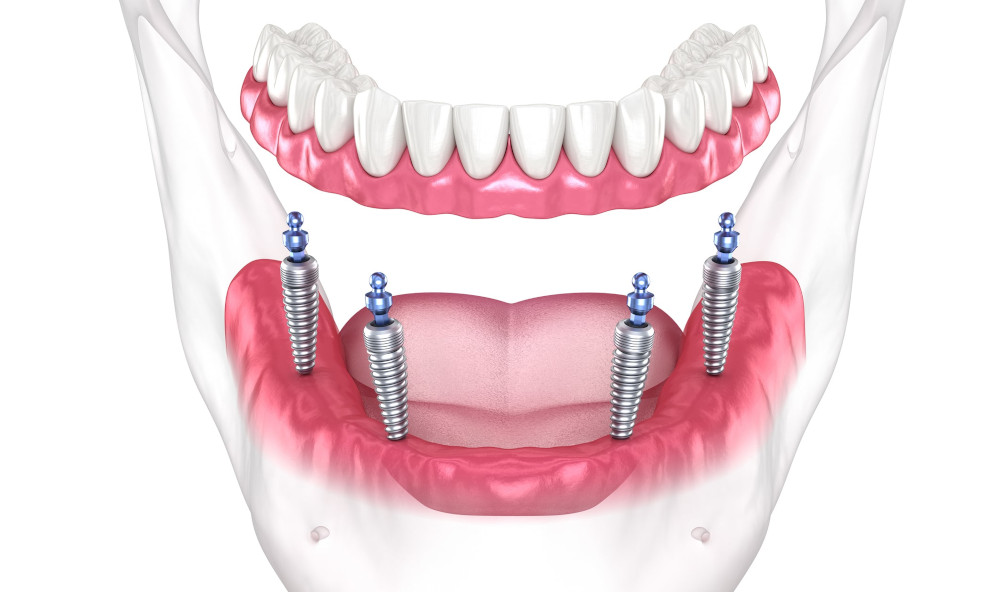
Are Dentures Still a Good Alternative?
Removable dentures remain a viable option for some patients, but they come with certain limitations. They can slip, cause sore spots, and require adhesives or frequent adjustments over time.
All on Four implants, on the other hand, are permanently fixed and do not move. They restore nearly full biting strength, allowing you to enjoy foods like apples or steak again. They also prevent bone loss — a significant issue with long-term denture use — by stimulating the jawbone just like natural teeth.
| Comparison | Dentures | All on Four Implants |
|---|---|---|
| Fit and Comfort | Can slip or cause discomfort | Permanently fixed, stable |
| Appearance | It can look artificial over time | Natural, lifelike look |
| Bone Preservation | Bone resorption occurs over time | Preserves jawbone structure |
| Maintenance | Must be removed and cleaned daily | Brushed and maintained like real teeth |
| Longevity | Needs replacement every 5–10 years | It can last decades with proper care |
If you’ve ever experienced the frustration of loose dentures, All-on-4 implants offer a secure, natural-feeling alternative that enhances both confidence and quality of life.
How Much Do All-on-Four Dental Implants Cost in Mississauga?
While the initial cost is higher than that of dentures, the long-term investment pays off in comfort, confidence, and durability. Unlike dentures, which need replacement and ongoing supplies, All on Four implants require little maintenance and can last for decades.
When evaluating cost, consider:
- Fewer implants mean shorter surgical time and lower costs than with individual implants.
- Immediate function — no need for temporary dentures.
- Long-term value through bone preservation and permanent stability.
How Do You Care for All on Four Dental Implants?
One of the most significant advantages of All on Four is how easy they are to maintain. You can care for them just like natural teeth:
- Brush twice daily with a soft-bristle toothbrush.
- Floss or use water flossers to clean around the bridge and gum line.
- Rinse with antibacterial mouthwash to reduce plaque.
- Schedule regular checkups and professional cleanings (typically every 6 months).
Unlike dentures, there’s no need to remove your teeth at night, and you’ll never have to deal with adhesives or soaking solutions again.
What Are the Risks or Limitations?
As with any surgical procedure, there are minor risks associated with All-on-Four implants, such as infection, implant failure, or temporary swelling. However, when performed by experienced professionals, the success rate exceeds 95–98%.
Patients with existing bone or gum issues can still often qualify, especially with modern diagnostic imaging and computer-guided implant placement used at Skymark Smile Centre.
Who Is a Good Candidate?
You may be a strong candidate if you:
- Have multiple missing or failing teeth
- Wear full dentures
- Have sufficient jawbone density (or are open to bone grafting if needed)
- Are in good general health and maintain oral hygiene
Your dentist will evaluate your unique anatomy and discuss personalized treatment options.
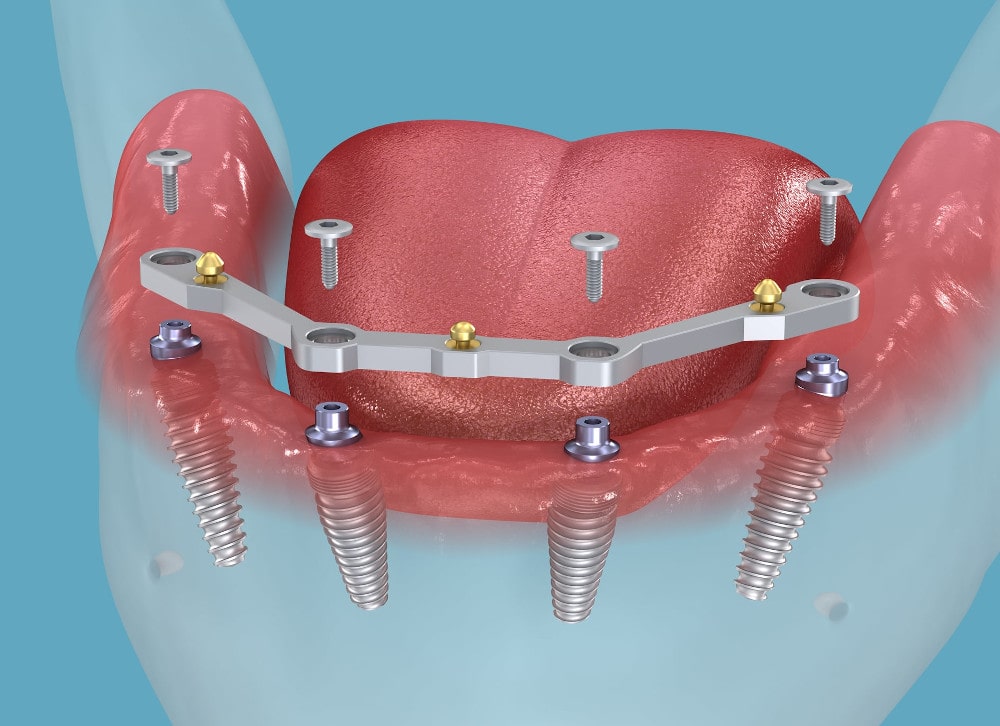
The All on Four Procedure: Step-by-Step
1. Initial Consultation & 3D Imaging
Comprehensive examination and 3D CT scan to assess bone quality and plan implant placement.
2. Implant Placement
Four implants are strategically placed under local or sedation anesthesia.
3. Temporary Prosthesis (Same Day)
A temporary full-arch bridge is attached immediately — you leave with a full set of teeth.
4. Healing & Integration (3–6 months)
Implants fuse with the bone in a process called osseointegration.
5. Final Prosthesis Placement
The permanent, custom-designed bridge replaces the temporary one for long-term use.
Benefits of All-on-Four Dental Implants
- Restores full chewing ability
- Prevents bone loss and facial sagging
- Offers immediate results (“Teeth in a Day”)
- Improves speech and confidence
- Long-lasting and durable
- Easy maintenance
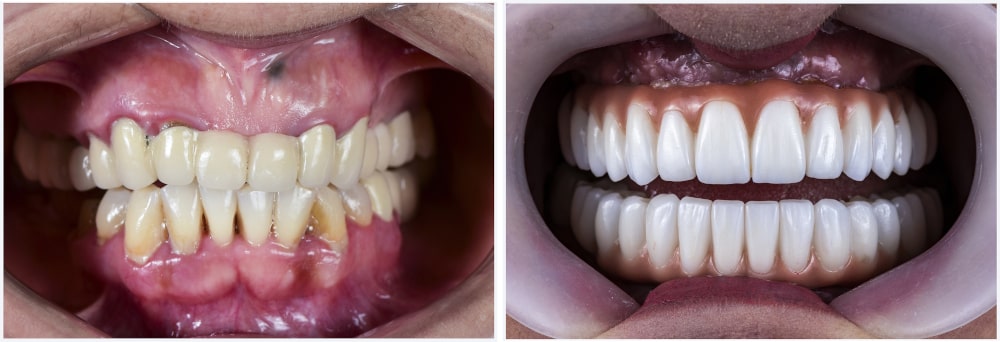
Key Signs You’re Ready for All on Four
You may be ready for All on Four if you:
- Struggle with loose or uncomfortable dentures
- Want a permanent, natural-looking smile.
- Desire immediate results with minimal downtime
- Want to improve your oral health and confidence.
Final Thoughts
All-on-Four dental implants combine science, artistry, and innovation to give patients a stable, natural-looking smile in a single day. At Skymark Smile Centre, Dr. Goli Ariafar and Dr. Rob Eisen have helped countless patients restore their confidence through this life-changing procedure.
If you’re considering Teeth in a Day or looking for a reliable alternative to dentures, schedule a consultation today. You’ll discover how modern implant technology can help you eat, smile, and live with confidence again.
Frequently Asked Questions
How long do All-on-Four dental implants last?
With proper care, they can last 20 years or more, often a lifetime.
Is the procedure painful?
Most patients report minimal discomfort. Sedation and local anesthesia are used for comfort during the procedure.
How long is the recovery time?
You can resume most daily activities within a few days. Full healing typically takes 3–6 months.
Can smokers get All-on-Four implants?
Yes, but smoking can slow healing and increase the risk of implant failure. Your dentist will provide guidance.
Are All-on-Four implants covered by insurance?
Coverage varies. While many plans don’t fully cover implants, partial reimbursement for procedures or materials may be possible.

